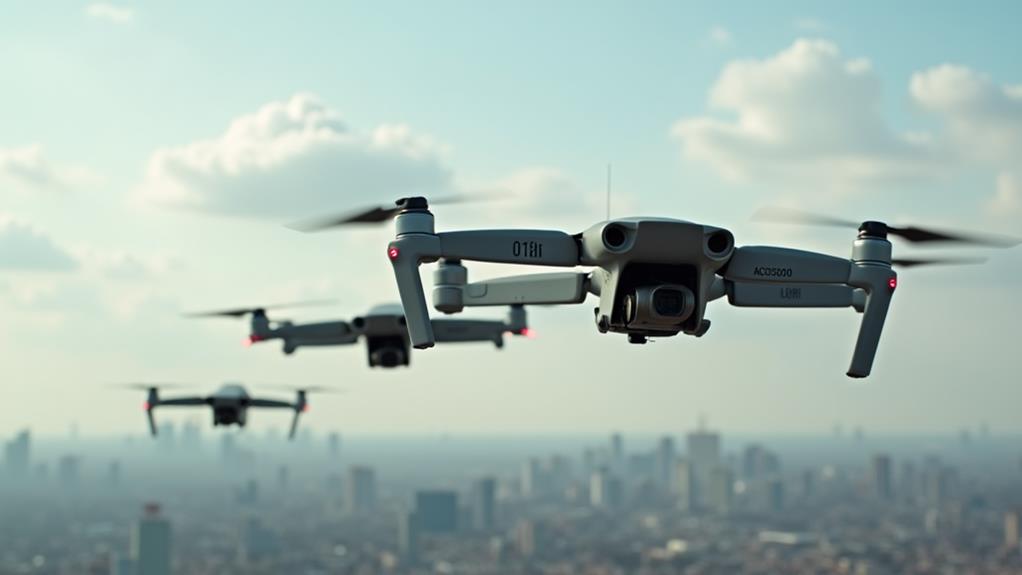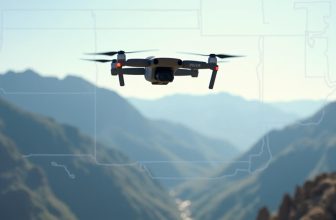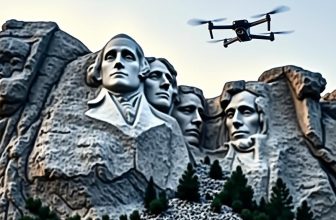
As you navigate the complex landscape of drone regulation, you're likely to encounter the phrase "know before you go," a principle borrowed from the aviation industry. Implementing drone remote identification is no exception, as it requires a multifaceted approach that balances technical integration, regulatory compliance, and stakeholder collaboration. Authorities, manufacturers, and operators must work together to establish standardized protocols and incorporate remote identification capabilities into their systems. But as you consider the benefits of enhanced public safety and security, you can't help but wonder: what are the key challenges that must be addressed to make this vision a reality?
Contents
- 1 Key Takeaways
- 2 Understanding Drone Remote Identification
- 3 Key Benefits for Public Safety
- 4 How Remote ID Systems Work
- 5 Technical Requirements and Standards
- 6 Implementation Challenges and Solutions
- 7 Impact on Drone Regulations Worldwide
- 8 Future of Remote Identification Technology
- 9 Frequently Asked Questions
- 10 Conclusion
Key Takeaways
- Drone remote identification implementation involves tracking and verifying drone compliance in real-time to enhance air traffic management.
- Implementing the system requires a balance between security and privacy, with secure data transmission and protected operator information.
- Drone remote identification enhances public safety by tracking and responding to unauthorized drone flights in real-time.
- A standardized data transmission format, such as ASTM F3411, and RF communication protocols are essential for seamless communication.
- Effective implementation requires addressing airworthiness, operator liability, and cybersecurity risks to ensure regulatory compliance.
Understanding Drone Remote Identification
As you explore into the world of drones, understanding drone remote identification becomes essential for safe and responsible drone operations.
Drone remote identification is a system that allows authorities to identify and track drones in real-time, verifying compliance with regulations and enhancing air traffic management.
This technology is vital in preventing unauthorized drone flights in restricted areas, such as near airports, and mitigating potential risks to air traffic.
Implementing drone remote identification also raises concerns about drone privacy.
Operators must guarantee that the transmitted data is secure and protected from unauthorized access.
The system should be designed to provide only the necessary information to authorities, while maintaining the operator's anonymity.
This balance between security and privacy is vital for widespread adoption of drone remote identification.
Key Benefits for Public Safety
Implementing drone remote identification systems can substantially bolster public safety by enhancing the authorities' ability to track and respond to unauthorized drone flights in real-time.
This capability addresses public concerns regarding the misuse of drones, such as their potential use in malicious activities or invasion of privacy. By providing real-time information on drone flights, authorities can respond promptly to incidents, thereby reducing the risk of accidents or injuries.
Remote identification systems also facilitate community engagement by enabling the public to report suspicious drone activities.
This collaborative approach fosters a sense of responsibility among community members, who can now contribute to maintaining public safety.
Some key benefits of drone remote identification systems for public safety include:
- *Enhanced incident response*: Authorities can quickly respond to unauthorized drone flights, reducing the risk of accidents or injuries.
- *Increased community engagement*: The public can report suspicious drone activities, fostering a collaborative approach to maintaining public safety.
- *Improved accountability*: Drone operators can be held accountable for their actions, reducing the likelihood of misuse.
- *Reduced risk of malicious activities*: Authorities can track and respond to drones being used for malicious purposes, such as surveillance or smuggling.
- *Better data-driven decision-making*: Authorities can make informed decisions based on data from remote identification systems, enhancing public safety strategies.
How Remote ID Systems Work
The ground control station serves as the central hub for drone tracking and monitoring.
Authorities can access the station to view drone flight paths, receive alerts for suspicious activity, and respond accordingly.
By integrating airborne networks with ground control stations, remote ID systems provide an exhaustive framework for drone tracking and management.
This infrastructure enables you to effectively monitor and respond to drone flights, ensuring public safety and security.
Technical Requirements and Standards
Remote ID systems rely on standardized protocols to guarantee seamless communication between airborne networks and ground control stations.
As you implement a drone Remote ID system, it's vital to understand the technical requirements and standards that govern its operation.
Standardization efforts are underway to certify that different systems can communicate effectively with each other, thereby mitigating interoperability issues.
To certify a functional and compliant system, consider the following technical requirements:
- Data transmission format: The system should use a standardized data transmission format, such as ASTM F3411, to certify that the data is readable and usable by different systems.
- Radio Frequency (RF) communication: The system should use RF communication protocols, such as Bluetooth or Wi-Fi, to transmit data between the drone and the ground control station.
- Cybersecurity measures: The system should implement robust cybersecurity measures to prevent data breaches and unauthorized access.
- Location determination: The system should use a location determination method, such as GPS or GNSS, to accurately determine the drone's location.
- Data storage and management: The system should have a secure data storage and management system to store and process the collected data.
These technical requirements and standards are essential to certifying a functional and compliant drone Remote ID system.
Implementation Challenges and Solutions
As you implement drone remote identification systems, you'll encounter regulatory compliance issues stemming from varying national and international standards.
You'll also face technical integration hurdles when incorporating remote identification capabilities into existing drone systems.
Managing these challenges effectively will be vital to successful implementation and ensuring seamless operation of your drone fleet.
Regulatory Compliance Issues
Several regulatory compliance issues are anticipated to arise during the implementation of drone remote identification systems.
As you navigate the complex regulatory landscape, verifying the potential challenges and developing strategies to address them is crucial.
One of the primary concerns is airworthiness, as remote identification systems may impact the overall airworthiness of the drone. You must guarantee that the system is properly designed, tested, and certified to meet regulatory requirements.
Another significant issue is operator liability. With remote identification systems, operators may be held liable for any errors or malfunctions. You must establish clear policies and procedures to mitigate this risk and guarantee that operators are properly trained.
You should also be aware of the following regulatory compliance issues:
- *Data protection and privacy concerns*: Verifying that remote identification systems comply with data protection regulations and respect individual privacy rights.
- *Cybersecurity risks*: Protecting remote identification systems from cyber threats and data breaches.
- *Interoperability and standardization*: Guaranteeing that remote identification systems are compatible with existing infrastructure and meet industry standards.
- *Compliance with existing regulations*: Guaranteeing that remote identification systems comply with existing regulations, such as those related to drone operations and airspace management.
- *Liability and insurance requirements*: Understanding the liability and insurance requirements for remote identification systems.
Technical Integration Hurdles
Implementing drone remote identification systems involves overcoming a multitude of technical obstacles.
You'll encounter challenges related to system interoperability, as different drone manufacturers and standards may not seamlessly integrate. Verifying that your remote identification system can communicate effectively with various drone systems is vital for its success.
Developing a common data exchange format can help alleviate this issue.
Another significant hurdle is network congestion. As the number of drones in the airspace increases, so does the amount of data transmitted between drones, ground control stations, and remote identification systems.
This can lead to network congestion, resulting in delayed or lost data transmissions. To mitigate this, you can implement data compression techniques, prioritize data transmission, or utilize edge computing to process data closer to the source.
When addressing these technical integration hurdles, pivotal factors to weigh are scalability, flexibility, and reliability.
Impact on Drone Regulations Worldwide
As you consider the widespread adoption of drone remote identification, you'll notice its profound impact on the global regulatory landscape, as governments worldwide update their policies to incorporate this technology.
You'll see changes in compliance requirements, as drone manufacturers and operators must adapt to new standards and protocols.
You'll also observe shifts in enforcement strategies, as authorities leverage remote identification to monitor and regulate drone activity more effectively.
Global Regulatory Landscape
The global regulatory landscape for drone remote identification is rapidly evolving, driven by increasing concerns over public safety, security, and privacy.
As you navigate this complex environment, it is crucial to understand the global frameworks and regional harmonization efforts shaping drone regulations worldwide.
Global frameworks, such as those developed by the International Civil Aviation Organization (ICAO), provide a foundation for countries to establish their own drone regulations.
Regional harmonization efforts, like the European Union's (EU) drone regulations, aim to create a unified regulatory environment within regions.
Key aspects of the global regulatory landscape include:
- Establishment of standardized remote identification protocols
- Development of global drone tracking systems
- Implementation of electronic identification transponders
- Harmonization of drone registration requirements
- Standardization of data exchange formats for remote identification data
Compliance and Enforcement
Maintaining compliance with remote identification regulations is pivotal for upholding public trust and preventing malicious drone operations.
You'll need to understand the various methods used to enforce these regulations globally. Effective compliance and enforcement procedures are fundamental to creating a safe and secure drone ecosystem.
Compliance mechanisms include drone registration, certification, and oversight of drone manufacturers and operators.
You'll also see the use of technology, such as remote identification and tracking systems, to monitor drone flights.
Law enforcement agencies play a pivotal role in enforcing these regulations, conducting investigations and penalizing non-compliant operators.
Agency coordination is also essential for effective enforcement.
You'll see collaboration between aviation authorities, law enforcement agencies, and other stakeholders to share information and best practices.
This coordination enables agencies to respond quickly to security threats and incidents, guaranteeing the safe integration of drones into the airspace.
Future of Remote Identification Technology
Some potential advancements to expect include:
- Enhanced data analytics: Integration with AI and machine learning algorithms to improve data analysis and decision-making.
- Automated tracking: Use of AI-powered systems to automatically track and identify drones in real-time.
- Increased security: Implementation of robust cybersecurity measures to protect against potential threats and vulnerabilities.
- Improved interoperability: Standardization of remote identification protocols to guarantee seamless communication between different systems.
- Advanced authentication: Development of more sophisticated authentication methods to prevent unauthorized access and verify secure identification.
Frequently Asked Questions
Can Any Drone Be Modified for Remote ID Compliance?
You can modify most drones for compliance, but it's vital to weigh the cost-effectiveness and choose a reputable third-party solution to guarantee seamless integration of the necessary hardware and software for remote ID functionality.
Are Hobbyist Drones Required to Have Remote Id?
You'll find that hobbyist drones, in most cases, aren't exempt from registration requirements. Drone enthusiasts must register their drones with the FAA if they weigh more than 0.55 pounds, and in some cases, remote ID may be required.
What Countries Exempt Drones From Remote ID Requirements?
Imagine flying a drone over Japan's vast rice fields. You'll find that countries like Japan exempt drones under 200g from remote ID requirements. National exemptions and international variations exist, such as Australia's model aircraft exemptions.
How Often Must Remote ID Systems Be Updated?
You must regularly update remote ID systems with software updates, typically every 6-12 months, to guarantee peak performance, security, and compliance, as part of ongoing system maintenance to prevent technical issues and errors.
Can Law Enforcement Access Remote ID Data Retroactively?
You're probably wondering if authorities can dig up your entire online history – in this case, law enforcement can access remote ID data retroactively, but only with lawful access, respecting data privacy boundaries and protocols.
Conclusion
As you implement drone remote identification, consider the case of the European Union's U-space initiative, which successfully integrated remote ID systems into drone operations. This achievement demonstrates the potential for seamless communication between airborne networks and ground control stations, ensuring secure data transmission. By addressing airworthiness, operator liability, and cybersecurity risks, you can enhance public safety and security. Effective implementation requires a multifaceted approach, involving technical integration, regulatory compliance, and stakeholder collaboration.






